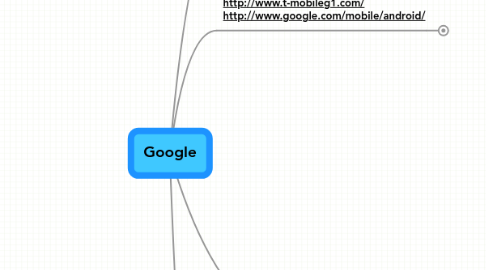
1. Android T-Mobile G1 Phone http://www.t-mobileg1.com/ http://www.google.com/mobile/android/
1.1. Hardware http://www.htc.com/
1.1.1. Highlights
1.1.1.1. 3.2-inch TFT-LCD flat touch-sensitive screen with HVGA (320 X 480 pixel) resolution
1.1.1.2. Full 5-row QWERTY keyboard.
1.1.1.3. One-Touch Google Search™
1.1.1.4. Instant Email, text message and IM notifications
1.1.1.5. Instant access to mobile Internet services (Gmail™, YouTube™, Google Maps™, Google Talk™, Google Calendar™)
1.1.1.6. High-speed 3.5G network connection
1.1.1.7. Wi-Fi technology with seamless transition to open networks
1.1.1.8. Android Market™
1.1.1.9. 3.2 megapixel color camera with auto focus
1.1.1.10. microSD™ (SD 2.0 compatible) expansion slot
1.1.1.11. manufacturer HTC of Taiwan, SIM-locked
1.1.1.12. Available developers (unlocked) phone edition
1.1.2. Specification
1.1.2.1. Qualcomm MSM7210A running @ 528 MHz
1.1.2.2. Android™ OS
1.1.2.3. Memory 256 MB ROM/ 192 MB RAM
1.1.2.4. Network HSPA/WCDMA: Europe: 2100 MHz, Up to 7.2 Mbps down-link (HSDPA) and 2 Mbps up-link (HSUPA) speeds
1.1.2.5. Quad-band GSM/GPRS/EDGE: 850/900/1800/1900 MHz
1.1.2.6. Trackball with Enter button
1.1.2.7. GPS navigation
1.1.2.8. Bluetooth® 2.0 Wi-Fi®: IEEE 802.11b/g HTC ExtUSB™
1.1.2.9. Battery - five hours of talk time and 130 hours of standby time
1.1.2.10. Digital Compass, Motion Sensor
1.1.3. Hardware review http://www.engadget.com/2008/10/16/t-mobile-g1-review-part-1-hardware/
1.2. Software
1.2.1. Android OS
1.2.1.1. Open source based on Linux (Apache free software and open source license)
1.2.1.2. Developed by Open Handset Alliance http://www.openhandsetalliance.com/
1.2.1.2.1. T-Mobile
1.2.1.2.2. Vodafone
1.2.1.2.3. Intel
1.2.1.2.4. NVIDIA
1.2.1.2.5. Asus
1.2.1.2.6. Motorola
1.2.1.2.7. Google
1.2.1.2.8. eBay
1.2.1.2.9. etc ...
1.2.1.3. Apps in Java, unofficially C compiled to ARM
1.2.1.4. Possible Android-powered netbooks/eee, Kogan Agora http://www.kogan.com.au/, Samsung android devices, Motorola android development team, T-mobile G2 – no QWERTY, coming May, Multitouch(?)
1.2.1.5. 2D, 3D graphics (OpenGL ES)
1.2.2. Applications
1.2.2.1. Web Browser based on WebKit (iPhone, Nokia’s S60 browser )
1.2.2.2. Easy access to many of Google’s services (one-touch to Gmail, YouTube, Calendar, Maps, G-talk)
1.2.2.3. Read Microsoft Word, Excel files
1.2.2.4. Android Market http://www.android.com/market
1.2.2.5. SDK v 1.0 http://code.google.com/intl/de/android/RELEASENOTES.html
1.2.3. Software, UI review http://www.engadget.com/2008/10/16/t-mobile-g1-review-part-2-software-and-wrap-up/
1.3. G1 vs iPhone http://www.thesmartpda.com/50226711/tmobile_g1_vs_iphone_3g_spec_comparison.php http://1.bp.blogspot.com/_GAoV1ZN5Q1U/SNNqOE2TH5I/AAAAAAAAALQ/UkvIV3uKojk/s1600-h/stoneiphonewm8.jpg
2. Services http://www.google.com/options/
2.1. Web
2.2. Mail (offline version with Google Gears)
2.3. Calendar (going offline)
2.4. Maps
2.5. Images
2.6. Shopping
2.7. Reader (also offline)
2.8. More
2.8.1. Video
2.8.2. Groups
2.8.3. Books (mobile version)
2.8.4. Scholar
2.8.5. Finance
2.8.6. Blogs
2.8.7. Documents (offline)
2.8.8. Sites
2.8.9. Translate http://translate.google.com
2.8.10. G-talk
2.8.11. Even more
2.8.11.1. Alerts
2.8.11.2. Blog search
2.8.11.3. Google Chrome
2.8.11.4. Directory
2.8.11.5. Image search
2.8.11.6. News
2.8.11.7. Code http://code.google.com
2.8.11.7.1. Product
2.8.11.7.2. Resources
2.8.11.8. Research http://research.google.com/
2.8.11.8.1. University Relations
2.8.11.8.2. Tech talks
2.8.11.8.3. Publications
2.8.11.9. Mobile
2.8.11.9.1. Blackberry
2.8.11.9.2. iPhone
2.8.11.9.3. Java, Symbian, Win Mobile, etc.
2.8.11.9.4. T-Mobile G1 (Android)
2.8.11.10. Health
2.8.11.11. Earth
2.8.11.12. etc.
2.8.11.13. List of services in mindmap http://www.gogeometry.com/mindmap/google_product_help.html
3. Examples of learning solutions
3.1. Apple experience
3.1.1. iPhone in Enterprise http://www.apple.com/iphone/enterprise/?sr=hotnews?sr=hotnews.rss
3.1.1.1. Microsoft Exchange ActiveSync
3.1.1.2. Delivering email
3.1.1.3. Calendar
3.1.1.4. Contacts
3.1.1.5. Secure access to corporate resources
3.1.2. American InterContinental University Online (AIU Online) http://www.aiuonline.edu/ http://www.youtube.com/watch?v=3fcUMWqiLCs&eurl
3.1.3. Abilene Christian University http://www.acu.edu/technology/mobilelearning/video/connected.html
3.1.4. iTunes U http://www.apple.com/education/mobile-learning/
3.1.5. 4 universities announced that they will give iPhone to students http://your-free-iphone.blogspot.com/2008/08/universities-give-out-free-iphone-to.html
3.1.6. iPod in education http://www.ipodined.org/ http://scyuen.wordpress.com/2007/12/24/ipod-in-education/
3.2. Blackberry http://www.blackberry.com/select/offers/education/
3.3. Open resourses
3.3.1. Academic Earth (1500+ video lectures) http://academicearth.org/
3.3.2. Indira Gandhi National Open University http://reganmian.net/blog/2008/12/05/worlds-largest-university-opens-almost-all-its-materials/
3.3.3. The Open University http://openlearn.open.ac.uk/course/index.php
3.3.4. MIT http://ocw.mit.edu/OcwWeb/web/home/home/index.htm
4. G1 in Uni
4.1. Programming http://code.google.com/intl/de/android/toolbox/index.html
4.1.1. SDK for OS
4.1.1.1. Windows
4.1.1.2. Linux
4.1.1.3. Mac OS
4.1.2. Wi-Fi APIs
4.1.3. Location-Based Services
4.1.4. Media API
4.1.4.1. Audio
4.1.4.2. Video
4.1.4.3. Streaming media data
4.1.5. 2D/3D graphics
4.1.5.1. fast 2D compositing engine
4.1.5.2. fast 3D with OpenGL
4.1.5.3. hardware acceleration
4.1.6. Java - "Google's Android parts ways with Java industry group" http://www.builderau.com.au/blogs/syslog/viewblogpost.htm?p=339270880&feed=pt_programming
4.2. Software localization
4.3. Visualization
4.4. Interactions
4.4.1. Interfaces - UI elements http://www.droiddraw.org/widgetguide.html
4.4.2. Physical buttons
4.4.3. Touch screen
4.4.4. Accelerometer
4.4.5. etc
4.5. Different user levels (?)
4.5.1. new students - using apps
4.5.2. master students - developing apps
4.6. Research
4.6.1. Mean of research
4.6.2. As a research topic
4.7. G1 Advantages/disadvantages
4.7.1. Leading applications created by Google / individuals
4.7.1.1. Wide range of apps
4.7.1.2. Comparison to other companies / solutions
4.7.1.3. Media representations / publishing
4.7.1.4. Software development for private / public use
4.7.2. Fully customized, personification (scientific, daily-life)
4.7.3. Organizer/communicator (everything in one place, emails)
4.7.4. New services (i.e. GPS based)
4.7.5. Growing developers community
4.7.6. Open system - risk of hacking?
4.7.7. Java specific API
4.7.8. No homogenized platform
4.8. Additional links
4.8.1. MIT, Stanford and other colleges are teaching students to make mobile applications. http://www.forbes.com/2008/11/11/mobile-apps-colleges-tech-wire-cx_ew_1111mobileapps.html
4.8.2. NSF-REU 2008: Using Android to Promote Education in Mobile Device Development http://www.eng.auburn.edu/users/bakercr/Chris%20-%20Danny%20-%20Android.pdf
4.8.3. T-mobile G1 Applications/Education http://www.getjar.com/software/T-Mobile/G1/Applications/Education
